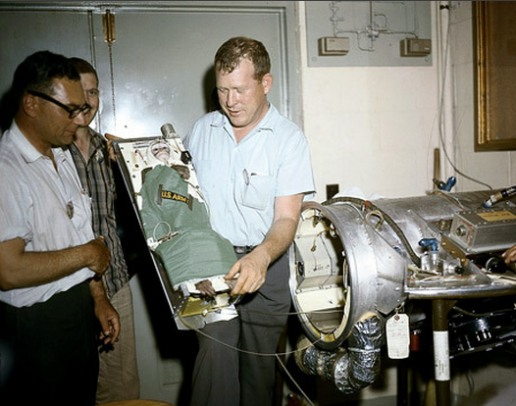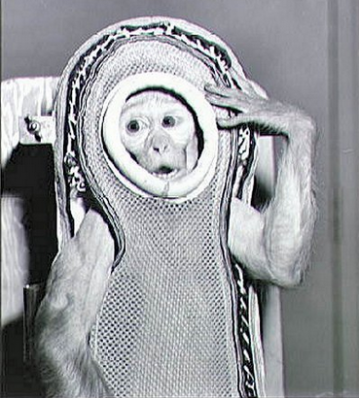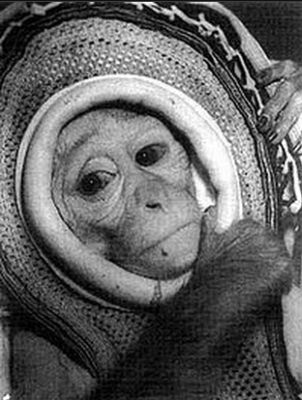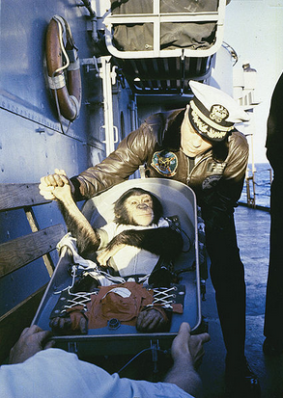Space Animals: Chimps, Monkeys & Dogs Who Became ‘Astronauts’
By Melissa Cronin
Astronaut Alan Shepard may have been America’s first man in space when he went up in 1961, but he wasn’t the nation’s first simian in space. That honor belongs to another Al — Albert II, a rhesus monkey that blasted aloft in 1949 aboard a V2 rocket.
Little Al was just one in a long line of monkeys, chimps, dogs, and other mammals that “volunteered” to help the U.S. explore the final frontier (Fruit flies, spiders, fish, frogs, and other non-mammals have also made the journey). From the Soviet space dog Laika, who flew aboard Sputnik 2 in 1957, to NASA’s charismatic astro-chimp Ham in 1961, to Pishgam, a monkey that reportedly was launched on a suborbital flight by Iran’s space program in January, mammals have continued to help us explore the heavens — mini-spacesuits and all.
Some of these intrepid creatures returned safely to Earth. Others weren’t so lucky. But all helped provide scientists with a wealth of information on the physiological effects of spaceflight.
And they looked pretty cute while they did it.
1. Albert II: June 14, 1949
Albert II was the first monkey in space. His capsule reached an altitude of 83 miles before returning to Earth. Alas, the little rhesus died on impact after a parachute failed during the descent.
Pic credit: NASA
2.
Baker: July 22, 1951
Baker, a squirrel monkey, was launched into space along with a rhesus monkey named Able. Unlike Albert II, they survived their 16-minute mission.
Pic credit: US Government, public domain
3.
Able: July 22, 1951
Able, a rhesus monkey, took off along with her companion Baker, becoming the first monkeys to survive the trip into space. However, Able died just a few days after the launch, during surgery to remove an infected electrode.
Pic credit: NASA
4.
Laika: November 3, 1957
No living creature had ever orbited the Earth until Laika, the Soviet Union’s celebrated space dog. The husky-terrier mix spent the trip aboard the Soviet spacecraft Sputnik 2, although she died within hours of the launch, likely from overheating.
Pic credit: NASA
5.
Sam: Dec. 4, 1959
Sam went up to an altitude of 53 miles. After returning safely to Earth, the rhesus was reunited with Miss Sam (who later went up on her own mission). How’d Sam and Miss Sam get their names? From the U.S. Air Force’s School of Aviation Medicine (SAM).
Pic credit: NASA
6.
Miss Sam: January 21, 1960
Just a month after her mate, Miss Sam took a trip into space herself. The rhesus survived the 8 minute 35 second flight, and attained a velocity of 1800 mph.
Pic credit: NASA
7.
Belka & Strelka: August 19, 1960
Belka (Russian for “squirrel”) and Strelka (“little arrow”) spent a day aboard the Russian satellite Sputnik 5. After their safe return, Strelka gave birth of six puppies, one of which was given to President Kennedy’s children. This image shows Strelka’s stuffed body on tour in Australia in 1993.
Pic credit: Wikimedia Commons
8.
Ham: January 31, 1961
Ham was the first chimpanzee launched into space by the U.S. space program. The ‘Astrochimp’ had a busy ride inside his Project Mercury capsule, pushing levers all the while to show that tasks could be performed in space. Ham’s name is an acronym for Holloman Aerospace Medical, the lab that prepared him for his historic mission.
Pic credit: NASA
9.
Enos: November 29, 1961
After Ham paved the way for chimps in space, Enos did one better by becoming the first chimp to orbit the earth. Carried by the Mercury Atlas 5 rocket, he completed two orbits of Earth. Enos reportedly ran around the recovery ship’s deck after he was let out of his capsule, shaking the hands of the crew.
Pic credit: NASA
10.
Pishgam: January 28, 2013
The Iranian Space Agency reportedly sent Pishgam (meaning ‘Pioneer’ in Farsi) on a suborbital flight 72 miles into space as the first in a series of flights intended to lead to human spaceflight.
Pic credit: Mahir Zeynalov
Article ripped off from the questionable Huffington Post (
link)









